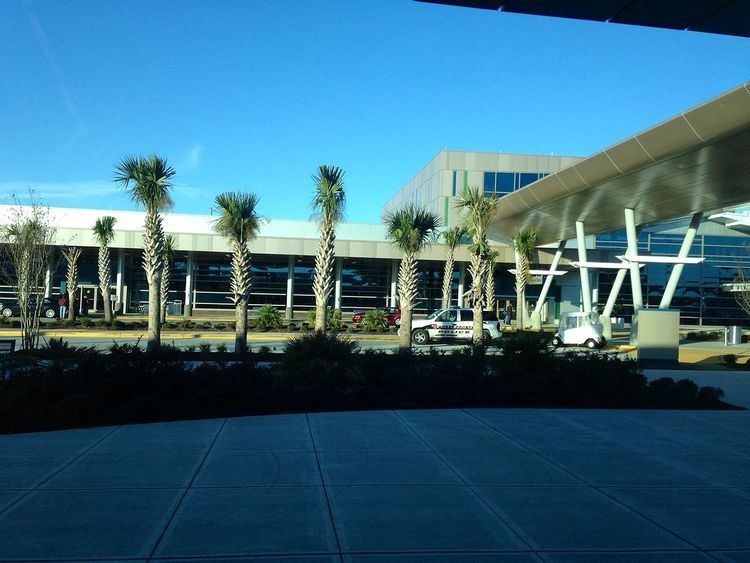Airport type Public Website FlyMyrtleBeach.com Elevation 7.6 m | Elevation AMSL 25 ft / 8 m Code MYR Phone +1 843-448-1589 | |
 | ||
Focus city for Allegiant AirSpirit Airlines Profiles | ||
Spirit airlines a320 landing at myrtle beach international airport hd
Myrtle Beach International Airport (IATA: MYR, ICAO: KMYR, FAA LID: MYR) is a county-owned public-use airport located three nautical miles (6 km) southwest of the central business district of Myrtle Beach, in Horry County, South Carolina, United States. It was formerly known as Myrtle Beach Jetport (1974–1989) and is located on site of the former Myrtle Beach Air Force Base, which also includes The Market Common shopping complex.
Contents
- Spirit airlines a320 landing at myrtle beach international airport hd
- Myrtle beach international airport myrtle beach south carolina
- History
- Renovations
- Facilities and aircraft
- References
The National Plan of Integrated Airport Systems for 2015-2019 categorized this facility as a primary commercial service airport. In 2014, the airport served a total of 1,749,657 passengers.
Myrtle Beach is the third-busiest airport in South Carolina behind Charleston and Greenville-Spartanburg, with nearly 1.7 million passengers (arriving and departing) in 2013. The airport is a focus city for Allegiant Air, and Spirit Airlines, which handles just over half of the total passengers using the airport.
The airport's official website since 2006 is flymyrtlebeach.com, which was previously an unofficial website owned by an airport employee. In July 2012 the airport launched a redesigned website with a new logo.
Myrtle beach international airport myrtle beach south carolina
History
Joint use of Myrtle Beach Air Force Base was first agreed in 1955. The airport and terminal was constructed in 1975 and opened in 1976. On April 20, 1977, an agreement between the City of Myrtle Beach and the U.S. Department of Defense was signed, which incorporated the area of Myrtle Beach Airport into the city. Until 1993, both MYR and Myrtle Beach AFB jointly used the main runway; this limited civil operations to 30 landings per day and led to a local business movement to build an entirely new airport.
In the 1980s, the airport was served by Piedmont Airlines mainline aircraft (later acquired by USAir) and by Delta and Eastern commuter aircraft.
In 1993, the Air Force closed the base as a result of BRAC 1991. The runway and other portions of the former military flight line were then turned over to the Horry County Department of Airports.
American Eagle became a major carrier at MYR in the early 1990s, operating multiple daily ATR 72 flights to the American Airlines hub at Raleigh-Durham International Airport. By late 1994 this route accounted for as much as 12% of the airport's passenger traffic; however, American abruptly ended its American Eagle hub at Raleigh-Durham in December 1994, cancelling all service to MYR and other secondary airports in the region. American returned to Myrtle Beach in 2010 with a seasonal service to Dallas-Fort Worth International Airport.
On April 1, 1996, Myrtle Beach Airport became an international airport. A new international terminal had its grand opening August 21 of that year, and a new logo was unveiled "to reflect the architectural design of the airport 's terminal and the influence of the beach by showing a pained window and a palm tree in blues and greens".
The airport served as the main hub for Hooters Air from 2003 until 2006. The airport authority offered discounted hangar space and other undisclosed benefits to Hooters Air operator Pace Airlines in an effort to relocate its operating base from Smith Reynolds Airport in Winston-Salem, North Carolina. However, Pace decided to keep its base (also used for charter operations) in Winston-Salem.
In 2006 AirTran Airways discontinued its service to Atlanta; it was the fourth-largest airline serving Myrtle Beach International at the time.
Direct Air connected a number of airports to Myrtle Beach from 2007 until 2012, when it abruptly filed for Chapter 7 bankruptcy and ceased operations. The failure of Direct Air caused a slump in passenger traffic at Myrtle Beach, which declined 16% in 2012 but rebounded in 2013. WestJet began service to Toronto in summer 2013 with a revenue guarantee from Horry County, but its passenger numbers fell short of expectations, forcing the county to pay WestJet around $570,000.
The airport was a designated launch abort site for the Space Shuttle, but was never used.
Renovations
In 2008 two renovations took place in the terminal building. In July 2010, the FAA approved a $4.50 passenger facilities charge on all airline tickets to and from MYR in order to defray part of the cost for the terminal upgrade.
Facilities and aircraft
Myrtle Beach International Airport covers an area of 3,795 acres (1,536 ha) at an elevation of 25 feet (8 m) above mean sea level. It has one runway designated 18/36 with an asphalt and concrete surface measuring 9,503 by 150 feet (2,897 x 46 m). The airport's entrance is on Harrelson Boulevard.
The Dr. W.L. Harrelson Terminal Building is named for Myrtle Beach's first mayor, Dr. W.L. Harrelson, who served from March 1938 to December 1939 and again from January 1942 to December 1943. The city purchased land for the municipal airport during his first term, and the terminal at the airport was named in his honor.
MYR has a dedicated helipad primarily used by charter tour companies at the base of runway 36.
For the 12-month period ending March 20, 2014, the airport had 145,347 aircraft operations, an average of 248 per day: 75% air taxi, 11% scheduled commercial, 11% general aviation, and 3% military. At that time 57 aircraft were based at the airport: 73% single-engine, 18% multi-engine, and 9% helicopter.
The airport has a dedicated air cargo building at the entrance of the airport.
